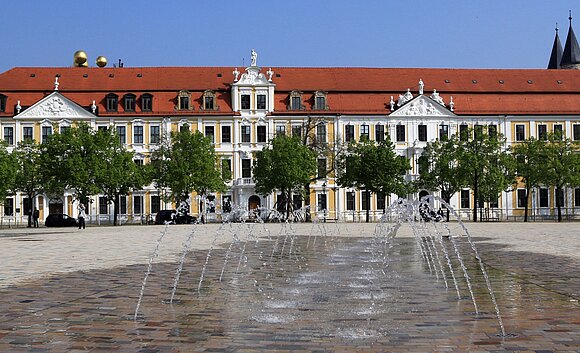After the German reunification, the Federal State Parliament of Saxony-Anhalt voted Magdeburg to be the state capital. Since January 17, 1991 the Federal State Parliament of Saxony-Anhalt meets directly on the opposite the 800-year-old cathedral “St. Catherine and Maurice”. The building complex Domplatz 7 – 9 was erected between 1724–1728. Between 1954–1956 the Parliament got its final shape, the war damages (Second World War) were repaired and the building on Domplatz No. 6 was newly erected.
A short insight in the history
The building development of the “Domplatz” (Cathedral Square) dates back to a concept of Prince Leopold von Anhalt-Dessau (also called “Der Alte Dessauer”). The fortress architect Gerhard Cornelius von Walrave lead the construction work of the houses on Domplatz Nr. 7 – 9.

Photo: Archives, Landtag
The reconstruction after the Second World War
During the Second World War the buildings on Domplatz 7 – 9 were destroyed. The reconstruction started in the year 1953. In order to have a closed ensemble of buildings, the house on No. 6 was built-on. As from the 1950’s onwards the buildings were used as an engineering school for water management.

Photo: Landtag
Seat of the Federal State Parliament of Saxony-Anhalt
Since the 17th January 1991, the Federal State Parliament of Saxony-Anhalt has its seat in this large complex of buildings. At that time, a successive rebuild was necessary: Former class rooms of the engineering school became counselling rooms for the different committees, the former ballroom became a plenary chamber.
On July 7, 1993 the general renovation of the buildings on Domplatz No. 8 and No. 9 culminated in the formal handover to the Members of Parliament. In 1996/97 the wings of No. 6, where the Plenary Chamber is located, were renovated during a construction period of one year. Between 2013 and 2014 renovation works took place in the entire complex of buildings and technical lines were adapted to the significantly changed standards in data communications.

